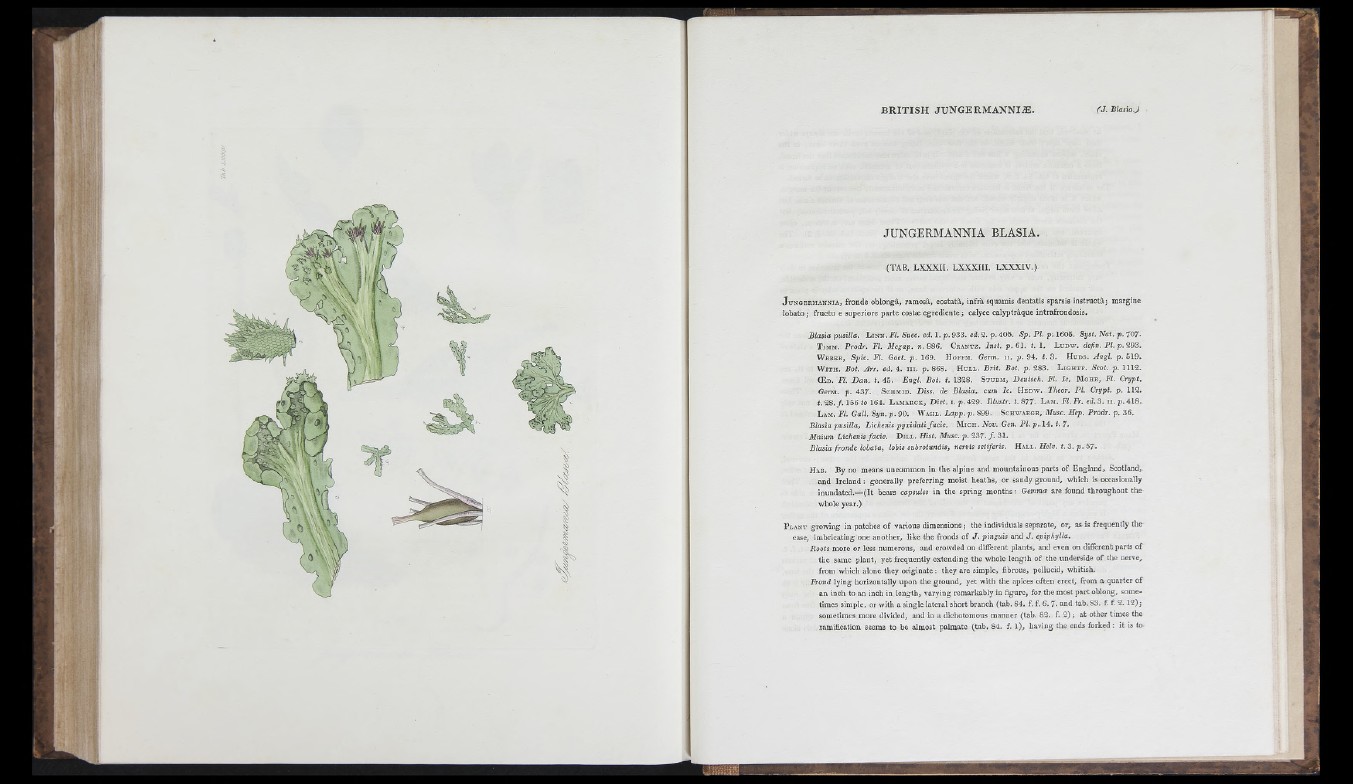
JU N G E RM A N N IA B LA S IA .
(TAB. L X X X II. LX X X III. LX X X IV .)
J u n g e rm a n n i a , fronde o b lo n g â , r am o s â , c o s ta t â , in f r â sq u am is d e n ta tis sp a rs is in s t r u c t â ; m a rg in e
lo b a to ; f r u c tu e s u p e r io r e p a r te c o s tæ e g re d ie n te ; c aly c e c a ly p tr â q u e in tr a fr o n d o s is .
Blasia pusilla. L i n n . TZ. Suec. ed. 1. p . 9 3 3 . ed. 2 . p . 4 0 5 . S p . Fl. p. 1 6 0 5 . S y st. N at. p. 7 0 7 .
T im m . P r o d r . Fl. Megap. n. 8 8 6 . G r a n t z . In s t. p . 6 1 . t. 1. L u d w . defin. Pl. p . 2 9 3 .
W e b e r , Spic. Fl. Goet. p . 1 6 9 . H o f fm . Germ. i i . p . 9 4 . i. 3 . H u d s . Angl. p . 5 1 9 .
W i t h . Bot. Arr. ed. 4 . i i i . p . 8 6 8 . H u l l . B r it. Bot. p . 2 8 8 . L i g h t f . Scot. p . 1 1 12 .
OE d . Fl. D a n . t. 4 5 . Engl. Bot. t. 1 3 2 8 . S t u rm , Deutsch. Fl. le . M o h r , Fl. Crypt.
Germ. p . 4 3 7 . S c h m id . Diss. de Blasia, cum le . H e d w . Tlieor. P l. Crypt. p . 1 1 2 .
t. 2 8 . / . 1 5 6 to 1 6 4 . L a m a r c k , D ie t. i. p . 4 2 9 . lUustr. t. 8 7 7 . L am . Fl. Fr. ed.3. i i . p . 4 1 8 .
L am , Fl. Gall. Sgn. p . 9 0 . W a h l , Lapp. p . 8 9 9 . S c h w a e g r , M usc. Hep. Prodr. p . 3 6 ,
Blasia pusilla, Lichenis p y x id a li fa d e . M i c h . N ov. Gen. Pl. p . 1 4 . i. 7.
Mtiïum Lichenis fa d e . D il l . Hist. Musc. p . 2 3 7 - / . 3 1 .
Blasia fronde lobata, lobis subrotundis, nervis setiferis. H a l l . HeZi>. Z. 3 . p . 5 7 .
H ab. By no means uncommon in th e alpine and mountainous parts o f E n g lan d , Scotland,
and Ireland ; generally pre fe rring moist h e a ths, or sandy ground, which is occasionally
inundated.— ( I t bears capsules in th e sp rin g m o n th s : Gemmce are found thro u g h o u t th e
whole year.)
P l a n t growing in patches o f various dimensions -, the individuals separate, or, as is frequently th e
case, imbricating one ano th e r, like th e fronds o f J . pinguis and J . epiphylla.
Roots more or less numerous, and crowded on different plants, and even on different p arts o f
th e same p lan t, yet frequently extending th e whole len g ih o f the underside o f the nerve,
from which alone they originate : they a re simple, fibrous, pellucid, whitish.
Frond lying horizontally upon the ground, yet with the apices often erect, from a qua rte r of
an inch to an inch in len g th , va rying remarkably in figure, for the m ost p a rt oblong, sometimes
simple, or w ith a single lateral short b ranch (tab. 84. f. f. 6. 7. and tab. 83. f. f. 2 .1 2 ) ;
sometimes more divided, and in a dichotomous manner (tab. 82. f, 2) ; a t other times the
ramification seems to be almost palmate (tab. 84. f, 1), having the ends forked : i t is to